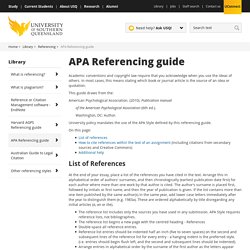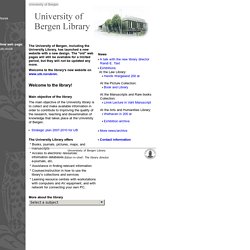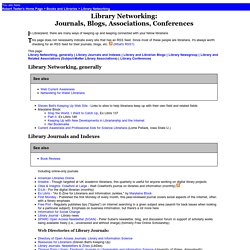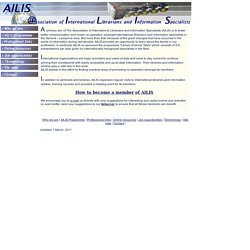

APA Referencing guide. Academic conventions and copyright law require that you acknowledge when you use the ideas of others.

In most cases, this means stating which book or journal article is the source of an idea or quotation. This guide draws from the: American Psychological Association. (2010). Publication manual of the American Psychological Association (6th ed.). Washington, DC: Author. University policy mandates the use of the APA Style defined by this referencing guide. On this page: How to cite references within the text of an assignment (including citations from secondary sources and Creative Commons) Harvard Referencing Web-CITE. Harvard Reference Generator Tool: Harvard/APA Referencing created for essays, reports and dissertations. About This Tool If you're a student and have ever had to write Reports, Essays or Theses, you will have had to reference what you have used in your report.

If you mention something that someone else has written, you need to give them credit by referencing them. The Harvard Referencing System is one of the preferred layouts for these references. It is a relatively strict way of arranging the bibliographical information. This tool takes in the raw information - author, title, year of publication - and creates the reference in the correct form. You can then highlight and copy this into the bibliography section of your report. You then reference this next to the relevant section within your essay in the format (Author, Year) such as (Smith, 2005). Paperpile. BibMe.
World's Most Beautiful Libraries. Wisdom Library. World Public Library. World Public Library - eBooks. Digital Bodleian. IFTTT - Make Your Work Flow. Library search engines. Finding the Right Digital Tool. Galileo Educational Network. Digital Public Library of America. Boston Public Library. University of Bergen Library. The University of Bergen, including the University Library, has launched a new website with a new design.

The "old" web pages will still be available for a limited period, but they will not be updated any more. Welcome to the library! Main objective of the library The main objective of the University library is to collect and make available information in order to contribute to improving the quality of the research, teaching and dissemination of knowledge that takes place at the University of Bergen. The University Library offers * Books, journals, pictures, maps, and manuscripts * Access to electronic resources: information databases, e-books, e-journals, etc. * Assistance in finding relevant information * Courses/instruction in how to use the library's collections and services * Learning resource centres with workstations with computers and AV equipment, and with network for connecting your own PC. More about the library. The Digital Shift - On Libraries and New Media, powered by Library Journal and School Library Journal. Home. NSW Public Libraries Association.
American Library Association. Library Management Software. University of Bergen Library. Library Journal — Library News, Reviews, and Views.
Aussie Library Blogs. Biblioburbia: The Library Files. Library Networking: Journals, Blogs, Associations, etc. In Libraryland, there are many ways of keeping up and keeping connected with your fellow librarians This page does not necessarily indicate every site that has an RSS feed.

Since most of these people are librarians, it's always worth checking for an RSS feed for their journals, blogs, etc. (What's RSS?) Bright Ideas. Index. English. Home page. Association of International Librarians and Information Specialists. A primary aim of The Association of International Librarians and Information Specialists (AILIS) is to foster better communication and closer co-operation amongst international librarians and information specialists in the Geneva - Lausanne area.

But more than that, because of the great changes that have occurred in the world of information during last decade, AILIS provides an opportunity to learn about the trends in our profession. In particular AILIS co-sponsors the programme "Library Science Talks" which consists of 5-6 presentations per year given by internationally recognized specialists in the field. International organizations are major providers and users of data and need to stay current to continue serving their constituents with easily accessible and up-to-date information. Their libraries and information centres play a vital role in this work .
Directories - Libraries. Digital Librarian: a librarian's choice of the best of the Web Directories: Libraries See Also: Librariana Africa Research Central - California State University, San Bernardino.

A search for library as a repository type retrieves 87 results. Archives Hub - A national gateway to descriptions of archives in UK universities and colleges. Les bibliothèques sur Internet en France dans le monde Association des Directers de Bibliotheques Departmentals de Pret. BibMe: Free Bibliography & Citation Maker - MLA, APA, Chicago, Harvard. Books That Bring History Into Context.
As Katherine Paterson writes in “Why Historical Fiction?”

“History gives us a pair of powerful eyeglasses with which to examine our own times. It is hard to look directly at our present reality because we are both too myopic and too faint-hearted.” History is alive, and historical books provide opportunities for young readers to experience times and places that, although not their own, have the potential to influence their understandings about the events of the past, the ways in which history both shaped and was shaped by individuals and groups of people, and how those people and events affect present realities.
Furthermore, literature can provide multiple perspectives on history and historical events, giving voice to those whose perspectives have been excluded from other accounts. The books featured in this post demonstrate the power of children’s literature—regardless of genre and text type—both to provide information for young readers and to tell the stories of history. Ages 4–8. Australian Library and Information Association. Deakin University Library.